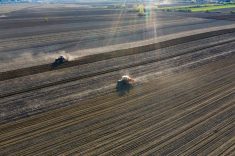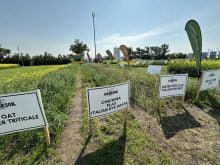In the early 1980s, we used a commonly seen bumper sticker in southern Alberta that stated, “Don’t Guess — Soil Test!” to promote the importance of soil testing. However, 40 years later, less than 20 per cent of Prairie farmers soil test their fields on a regular basis.
Why is this? For many farmers it comes down to a lack of trust in the fertilizer recommendations made either by the soil testing lab or by the person making the recommendations based on lab analysis. Most Prairie farmers are well aware of the potential advantages of soil testing but lack confidence in the interpretation.
Read Also

Claas brings 1000 Series SP forage harvesters to Canada
In mid-August, Claas unveiled its new line of Jaguar forage harvesters at an event in Visalia, California, deep in the heart of that state’s dairy region.
Table 1 (see further down) provides a fertilizer recommendation made this spring by a soil testing lab for spring wheat to be grown in central Alberta on a dark gray soil with a clay loam texture.
In this example, the soil test nitrate-nitrogen (NO3-N) level to 24 inches was 112 pounds of nitrogen (N) per acre. Assuming an estimated N mineralization of 30 pounds N per acre during the growing season, a more reasonable N recommendation would have been in the range of 60 to 70 pounds N per acre. The phosphate (P2O5) recommendation was reasonable. The soil test potassium (K) level in the zero- to six-inch depth was 242 pounds K per acre. Years of K research with wheat in Alberta has shown that wheat rarely responds to K fertilizer above a critical level of 250 pounds K per acre. A recommendation of 20 to 40 pounds K2O per acre would have been reasonable, but the lab recommended 100 pounds K2O per acre. The lab also recommended magnesium (Mg), boron (B), copper (Cu) and manganese (Mn). In my opinion, based on soil analysis (not provided), none of these fertilizers were needed and likely would not have significantly increased crop yield. Soil pH was 5.9 but the lab recommended three tons of lime per acre.
In this case, the recommendation of higher rates of N and K fertilizers along with four other unnecessary fertilizers would have significantly increased the per acre fertilizer cost to the farmer and likely would not have economically or agronomically increased crop yield. When farmers see these types of recommendations, it is little wonder why many are turned off soil testing.
Despite these concerns, I strongly encourage Prairie farmers to take advantage of soil sampling and testing to assess soil fertility in their fields to develop accurate fertilizer recommendations. In my opinion, soil testing is an invaluable tool when properly conducted. Farmers need to seek out reputable, well-educated and trained agronomists to assist with accurate soil sampling, ensuring samples are tested by a reputable lab and then to assist with wise interpretation based on local and regional fertilizer research in your province.
Soil testing is not only helpful to develop economically and agronomically sound fertilizer recommendations but it assists with monitoring and evaluating soil changes in the long term resulting from crop management practices. Soil analysis is also very useful for identifying and diagnosing problem soil issues.
What soil testing analyses are important?
I will not discuss soil sampling methods in this article but will focus on what soil analyses are important.
Table 1 below shows an example of a generalized soil test report and the various types of analyses provided. There are several soil testing labs located in Western Canada. Some agronomists use soil testing lab services in eastern Canada or the United States. When selecting a laboratory, ensure the laboratory uses the recommended soil test methods for your province.

Only request the soil tests you really need. Determining plant available nitrate-nitrogen, phosphorus, potassium and sulphate-sulphur are the most important. Nitrate-N and sulphate-S can vary considerably from year to year and should be tested to 24 inches (60 centimetres) each year. Phosphorus and potassium don’t change nearly as much from year to year, but I suggest testing the zero- to six-inch depth (zero to 15 centimetres) each year.
Almost all Prairie soils are well supplied with calcium (Ca) and magnesium (Mg). You can test for these levels once and, if adequate, there is no need to test again for several years.
The important micronutrients are boron (B), chloride (Cl), copper (Cu), iron (Fe), manganese (Mn) and zinc (Zn). When the level for each is in the adequate range, I suggest testing only once every five years. If one or more of the micronutrients are deficient, low or marginal, testing and monitoring each year may be necessary. Make sure interpretation of micronutrient levels is based on local and regional research and standards for your province.
Most labs will test for soil pH, soil salinity, which is measured as electrical conductivity (EC), and soil organic matter. Generally, these don’t change much from year to year, but I encourage monitoring for changes. Be aware that soil pH can fluctuate by up to a half unit over the growing season, depending on environmental conditions.
Some soil testing labs and agronomists recommend testing for cation exchange capacity (CEC) and base saturation percentage (BS). Normally, I do not recommend doing these analyses. CEC is a measure of the ability of the soil to hold positively charged cations and therefore is primarily a function of the amount of smectite clay in soil. Simply doing hand texturing of soil to estimate soil texture and thereby estimating clay content can be used to give a good estimate of soil CEC. Further, soil CEC does not change from year to year, so why do this soil test every year?
Some agronomists use base saturation percentage to make fertilizer recommendations for potassium, magnesium and calcium based on ratios such as K:Mg. This is a very seriously flawed concept and is not an accepted method to determine K, Mg or Ca fertilizers in Western Canada. This method has been used with highly weathered soils with very low CEC in the southern United States but has not been proven to be acceptable in Western Canada. I do not recommend determining base saturation percentage for making fertilizer recommendations.
Recommended laboratory methods of soil analyses
Below are the recommended methods of soil analyses for Western Canada.
Phosphorus can be determined using the Kelowna method, which employs ammonium fluoride and acetic acid. The widely used modified Kelowna method includes the addition of ammonium acetate. The modified Kelowna method is the recommended soil test P method for determining plant available soil P in Alberta and Saskatchewan and is also used for determination of plant available K in soil. The Kelowna method is recommended in British Columbia.
The sodium bicarbonate method (Olsen method) is the recommended soil test P method for Manitoba. For best 4R recommendations for phosphate fertilizer, be sure to use the recommended P method for your province.
Potassium is determined using the ammonium acetate extraction method or can be determined using the modified Kelowna method, which contains ammonium acetate.
Sulphate sulphur is determined using the calcium chloride extraction method.
Nitrate nitrogen is determined using the modified Kelowna method or calcium chloride method.
Soil pH is determined in a 1:1 or 2:1 ratio of distilled water to soil.
Electrical conductivity is determined by adding distilled water to the soil sample while stirring to create a saturated paste. Let stand, then vacuum remove the extract to determine electrical conductivity. This a measure of soil salinity.
Organic matter is determined either by the ignition method or wet oxidation method.
Copper, iron, manganese and zinc (metal micronutrients) are determined using the diethylenetriaminepentaacetic acid (DTPA) extraction method.
Boron is determined using the hot water extractable method. This test frequently underestimates soil boron levels and is poorly correlated with crop response.
Chloride is determined by extraction with water. This test often underestimates soil chloride levels and has not been well correlated with crop response.
After soil analyses are complete, review the results with your agronomist to ensure they are reasonable. Most labs will retain samples for 30 days and can rerun any samples that might be of concern.
Often soil testing labs will provide fertilizer recommendations. Most labs are not familiar with your specific soils and agro-climatic area of your farm. I always encourage farmers to work with an experienced and well-respected agronomist to assist with developing fertilizer recommendations. In the January 18, 2022, issue of Grainews, I will discuss the steps to wisely develop economic and agronomic fertilizer recommendations.















